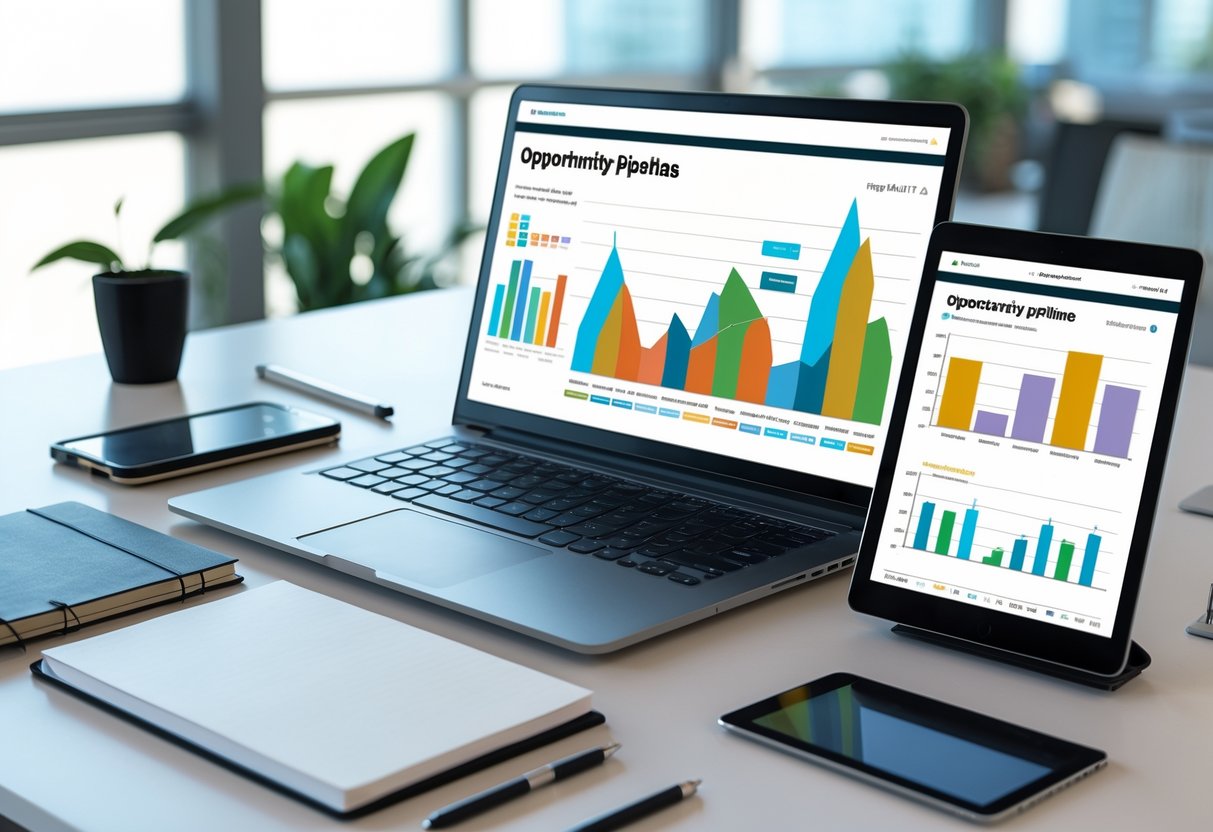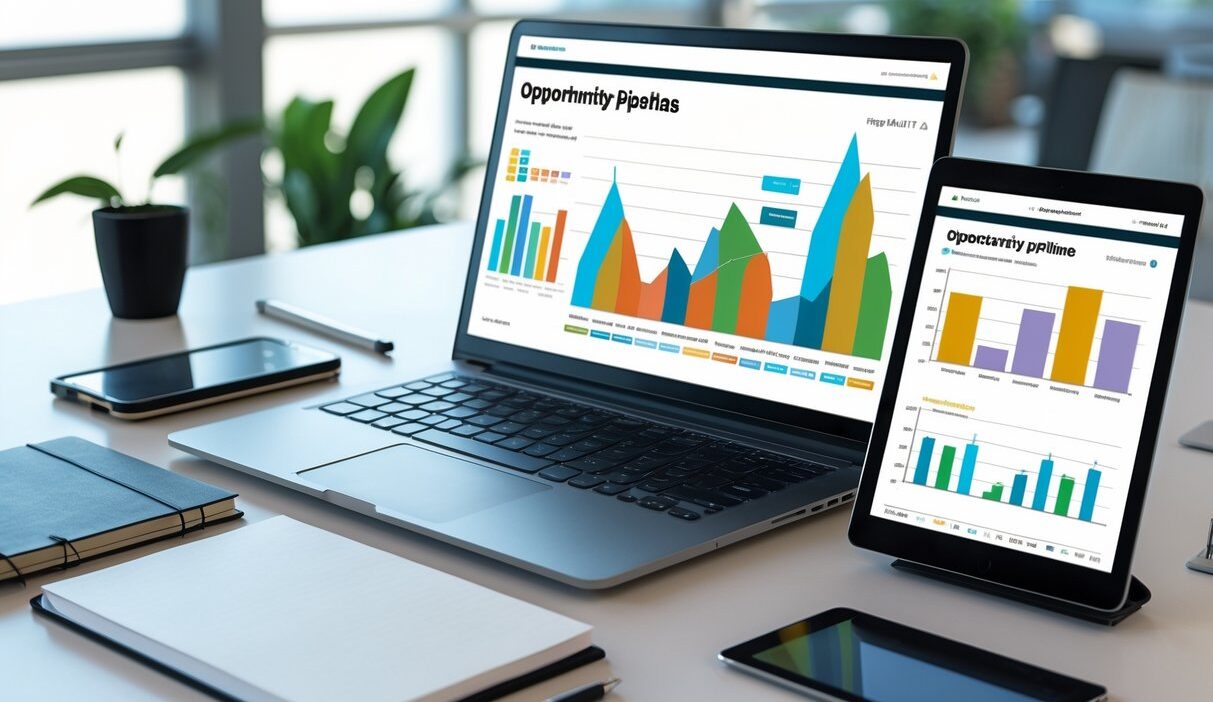Managing sales opportunities can feel like a never-ending juggling act if you don’t have the right tools. You need a clear way to track progress, spot trends, and make smarter decisions—without drowning in spreadsheets.
Opportunity pipeline tools help you organize every potential deal, prioritize actions, and actually improve sales performance with less guesswork.

I use these tools to see exactly where each opportunity stands and what needs my attention next. They make it so much easier to align sales goals with strategy and keep everyone focused on the deals that matter most.
Platforms like the Microsoft opportunity pipeline view or other CRM-based systems let me visualize the whole sales process in one place.
Key Takeaways
- Learn what opportunity pipeline tools actually do and why you should care.
- Understand how to use them to manage and improve your sales process.
- Discover ways to optimize performance and increase your deal success.
Understanding Opportunity Pipeline Tools
I use opportunity pipeline tools to track sales progress, measure performance, and make decisions that aren’t just guesses. These tools help me spot the strongest leads, manage relationships, and forecast revenue with a lot more confidence.
What Are Opportunity Pipeline Tools?
Opportunity pipeline tools are digital systems that help me organize and monitor every stage of the sales process. They show where each lead is—from first contact to closing a deal—and help me predict future revenue.
Common examples? CRM platforms like Salesforce, HubSpot, and Zoho. These tools visualize the sales funnel, automate boring tasks, and keep all your customer data in one place.
I customize stages, assign probabilities, and set reminders so nothing slips through the cracks. This structure helps me focus on high-value leads and keeps my sales process both consistent and measurable.
The Microsoft pipeline view lets me visualize and prioritize opportunities with a clear interface. I can instantly see which deals are at risk and which are moving forward without a hitch.
Key Benefits for Business Development
Pipeline tools boost my business development strategy by giving me visibility and control. I see how leads move through each stage, spot weak points, and tweak my approach to improve conversion rates.
Main benefits:
- Better forecasting: I can estimate future sales with more accuracy.
- Improved collaboration: Marketing and sales teams finally share data in one place.
- Increased efficiency: Automation cuts down on manual updates and saves everyone time.
Using structured tools like the FasterCapital opportunity pipeline framework helps me align marketing and sales. It ensures qualified leads get timely follow-ups and that I don’t waste time on dead ends.
How Managers Use Pipeline Tools
As a manager, I rely on pipeline tools to track team performance and steer strategy. Dashboards show metrics like deal size, win rate, and pipeline velocity—super helpful for spotting top performers and places where the team needs support.
I use reports to measure progress and forecast revenue. When deals stall, I can jump in with coaching or reallocate resources.
Tools like Cliently’s opportunity pipeline inspection let me compare leads and accounts to see which ones convert best. This data-driven approach makes sure I spend my time on the most profitable opportunities.
If you want to skip the hassle and just get high-quality leads delivered to you, feel free to contact me on WhatsApp at +917303556188. Why work so hard? Let’s make your sales process easier together.
Core Features and Functionalities

I look for tools that make it obvious where each deal stands and give me clear, actionable data. Connecting agreements to actual work? That’s a must. These features save me time and keep my sales activities aligned with delivery.
Pipeline Visualization and Stages
I love using pipeline visualization to see every opportunity in one glance. A visual layout—like a board or funnel—lets me track deals as they move through defined stages.
Each stage is a clear milestone, from lead qualification to contract close.
Modern platforms like Microsoft’s pipeline view let me customize stages and filter by owner, region, or deal size. This flexibility helps me focus on high-value opportunities and spot bottlenecks before they become problems.
I also rely on color coding, drag‑and‑drop movement, and progress indicators. These small touches make it easy to spot stalled deals and update records instantly.
| Stage | Description | Key Metric |
|---|---|---|
| Qualification | Assess fit and interest | Conversion rate |
| Proposal | Present pricing and scope | Win probability |
| Negotiation | Finalize terms | Cycle time |
| Closed | Won or lost | Revenue impact |
Opportunity Tracking and Analytics
Analytics are my best friend for measuring pipeline performance. I track metrics like deal velocity, average deal size, and close rate to spot trends and forecast revenue with more confidence.
Tools like Fireberry’s opportunity pipeline management put a spotlight on data visibility. I use dashboards to see the health of each stage and pinpoint where deals slow down.
I prefer platforms with built‑in reports and visual charts. They make it simple to compare team performance or analyze conversion rates by product line. Automated alerts help me jump in when a key deal shows risk—like no activity for a few days.
Statements of Work Integration
Integrating statements of work (SOWs) into the opportunity pipeline keeps sales and delivery on the same page. I attach draft SOWs directly to opportunities, so scope, pricing, and deliverables stay consistent from proposal to execution.
Some systems, like Dynamics 365’s opportunity pipeline view, let me link documents and track versions. This way, I don’t have to jump between tools.
I use templates to standardize SOW details like timelines, milestones, and payment terms. This cuts down on errors and saves time when I’m generating new agreements.
By connecting SOWs to analytics data, I can later compare planned versus actual performance and tweak future proposals.
Building and Managing an Effective Opportunity Pipeline
I focus on finding real sales opportunities, qualifying them with clear standards, and prioritizing them based on value and timing. That way, I use my time and resources where they’ll actually make a difference.
Opportunity Identification and Market Research
I start by defining my target market and understanding customer needs through market research. I analyze trends, competitor activity, and buyer behavior to spot where the real demand is.
I gather data from industry reports, customer surveys, and even social media analytics. Tools that visualize opportunities, like the pipeline view in Microsoft Dynamics 365, help me keep track of what matters.
Here’s how I organize my findings:
| Factor | Description | Impact |
|---|---|---|
| Market Size | Total potential customers | Determines revenue potential |
| Competitors | Key players and pricing | Helps position my offer |
| Customer Pain Points | Common challenges | Guides product messaging |
By mixing data and gut instinct, I figure out where my products fit best and which prospects are most likely to say yes.
Qualifying Opportunities
After I identify leads, I qualify them using structured criteria. I check for budget, authority, need, and timeline (BANT) to make sure the lead is worth chasing.
Scoring systems help me rank opportunities by fit and readiness. For example, a lead with a clear problem and decision-maker on board scores higher than someone just browsing.
I use CRM tools to track this qualification data. FasterCapital’s guide on opportunity pipeline management says consistent qualification makes forecasting more accurate and saves time.
I update qualification details regularly after calls, demos, or emails. That way, my pipeline stays realistic and focused on leads that actually have a shot.
Prioritization Strategies
I prioritize opportunities by revenue potential, closing probability, and urgency. Each opportunity gets a score that reflects these factors.
I check this list every week and adjust my focus. High-value deals close to the finish line get my attention first.
I also follow “lean pipeline management” from FasterCapital’s recommendations, focusing on the hottest leads and clearing out the dead weight.
Clear priorities mean better follow-up, stronger forecasting, and a more efficient sales process.
Honestly, if you don’t want to spend hours every week sorting and qualifying leads, just reach out to me on WhatsApp at +917303556188. I can get you solid leads so you can focus on closing—not chasing.
Optimizing Opportunity Pipeline Performance

I keep an eye on market trends, shift resources as needed, and refine my process using data reviews. These steps help me build a stronger sales pipeline, cut out inefficiencies, and boost conversion rates.
Competitive Analysis Techniques
I use competitive analysis to see how my pipeline stacks up against the competition. By studying their pricing, messaging, and customer engagement, I spot gaps and strengths in my own approach.
I track competitors using public data, industry reports, and CRM dashboards. This lets me benchmark my win rates, deal sizes, and sales cycle lengths.
| Metric | My Pipeline | Competitor Average | Goal |
|---|---|---|---|
| Win Rate | 32% | 28% | 35% |
| Average Deal Size | $18,000 | $15,500 | $20,000 |
I also monitor competitor activity with insights from FasterCapital’s opportunity pipeline strategies. This info lets me tweak my tactics and stay ahead.
Resource Allocation for Pipeline Success
I assign resources based on opportunity value and how far along a deal is. High-potential deals get more time, budget, and marketing support. Low-probability leads? They move down the list.
CRM tools help me visualize resource use and keep things balanced across the team. I make sure sales and marketing are on the same page, so our messaging stays consistent and we don’t waste effort.
Key steps for allocation:
- Rank opportunities by deal size and closing probability.
- Match skilled team members with complex or high-value accounts.
- Reassess allocations weekly using pipeline metrics.
I follow a method like the one in ARPEDIO’s pipeline management guide. It keeps my process efficient and grounded in real data.
And hey, if you’re tired of doing all this yourself, feel free to contact me on WhatsApp at +917303556188. I’ve got the leads, you’ve got the sales skills—let’s make it easy.
Continuous Improvement and Review
I check my pipeline every week, looking for bottlenecks or sudden dips in performance. Staying on top of data accuracy, updating opportunity stages, and clearing out inactive leads keeps things moving.
I dig into analytics—metrics like pipeline velocity, conversion rates, and sales cycle length. This stuff tells me what to do next and what skills I might need to sharpen.
I lean into lean pipeline management by zoning in on high-value opportunities only. I pull structured evaluation ideas from The Palos Publishing Company’s approach to strategic pipelines and tweak my process so every stage pushes for real growth.
Opportunity Pipeline Tools for Sales and Business Development

I use opportunity pipeline tools to keep tabs on leads, track progress, and make sure my resources aren’t wasted. These tools help me keep sales efforts in order and make my forecasts more accurate.
Honestly, it’s a relief knowing every opportunity gets the right attention at the right time. Why juggle it all in your head when you can let the tools do the heavy lifting?
Aligning Sales Processes with Pipeline Tools
If I want my sales process to run smooth—from lead generation to closing—I need a structured pipeline. Tools like Capture2Proposal’s pipeline management let me update and share reports with the team, saving me from manual headaches.
I map out every stage: prospecting, qualification, proposal, negotiation. The tool lays it all out, so I can spot which deals need a nudge or which ones are cruising along.
Benefits of alignment include:
- Faster replies to client questions
- Crystal-clear deal stages
- Better teamwork between marketing and sales
When my process and tools match up, I don’t miss deadlines or double up on work. If you’d rather not stress about this stuff, just reach out on Whatsapp at +917303556188. Feel free to contact me for consultation or if you want to buy quality leads—honestly, it’s way easier than building all this yourself.
Best Practices for Managers and Teams
As a manager, I count on pipeline tools to keep an eye on performance and help my team step up. Platforms like LeadAngel show me how fast leads move and where things slow down.
I set clear metrics for each stage—conversion rates, average deal size. This lets me spot who needs more support or maybe a bit of coaching.
Key practices I follow:
- Update pipeline data every day.
- Review reports once a week to catch trends.
- Use automation for task assignments and reminders.
These simple habits keep everyone focused. I trust my forecasts more and can put resources where they’ll actually matter.
Leveraging Analytics for Growth
Analytics turn pipeline data into real insight. I use dashboards to track lead sources, win rates, and sales velocity. Tools recommended by Unanet make it easier to see what’s working.
I compare current results with the past so I can catch growth trends. Here’s a quick look at how I track progress:
| Metric | Last Quarter | Current Quarter | Change |
|---|---|---|---|
| Win Rate | 32% | 38% | +6% |
| Average Deal Size | $12,000 | $13,500 | +12.5% |
Tracking these numbers lets me tweak my strategy early. Analytics also show me which marketing channels actually bring in good leads, so I can double down on what works.
If you’d rather just get straight to the good stuff—skip the trial and error—shoot me a Whatsapp at +917303556188. I’m happy to help you with lead buying or a quick consult.
Frequently Asked Questions
I use opportunity pipeline tools to track deals, manage data, and improve forecasting. These tools connect with CRM platforms, cover all sales stages, and help me analyze performance with clear metrics.
What are the top-rated opportunity pipeline tools currently available?
I stick with tools like HubSpot Sales Hub, Pipedrive, Zoho CRM, and Microsoft Dynamics 365 Sales. They offer customizable pipeline views, automation, and solid reporting dashboards. The opportunity pipeline view in Microsoft Dynamics 365 Sales is especially handy—managing deals visually just makes sense.
How do opportunity pipeline tools integrate with CRM systems like Salesforce?
Most tools have built-in integrations or APIs. Salesforce, for example, links pipeline stages with leads, contacts, and deals, so I can see everything in one place. When activities or revenue estimates change, the system updates opportunities automatically.
Can you list some free tools for managing an opportunity pipeline effectively?
I’ve tried out free versions of HubSpot CRM, Bitrix24, and Zoho CRM. They let me track contacts, deals, and tasks without shelling out for premium features. For small teams, these free tools offer enough visibility to keep things running.
What are the typical stages of an opportunity pipeline in sales management?
Most pipelines include Prospecting, Qualification, Proposal, Negotiation, and Closed (Won or Lost). Some companies add steps like Demo or Contract Review. GrowthMap explains how customizing stages helps track leads and clients better.
How do opportunity pipeline tools enhance sales forecasting and reporting?
These tools pull data from deals and activities to predict future revenue. In Dynamics 365 Sales, predictive scoring updates every day to sharpen forecast accuracy. I can check conversion rates, deal size, and win probability in real time.
If you want to skip the guesswork and get straight to buying leads or need some advice, just ping me on Whatsapp at +917303556188. Feel free to reach out—honestly, why work harder than you need to?
What features should be considered when selecting an opportunity pipeline tool for a small business?
I always check for ease of use first—nobody wants to wrestle with clunky software. Integration options come next, since you really need your tools to talk to each other.
Customizable stages? Absolutely. Every business has its own weird way of doing things, so you need flexibility. Reporting helps you see what’s working, and having mobile access just makes life easier.
Honestly, tools like Fireberry recommend setting up clear pipeline stages that actually fit your sales process. Makes tracking a breeze.
If you don’t want to waste time figuring all this out, just reach out on Whatsapp at +917303556188 for a quick consultation or to buy leads. Feel free to contact me—it’s way easier to get quality leads from someone who already knows the ropes. Why stress yourself when you can let me do the heavy lifting?



